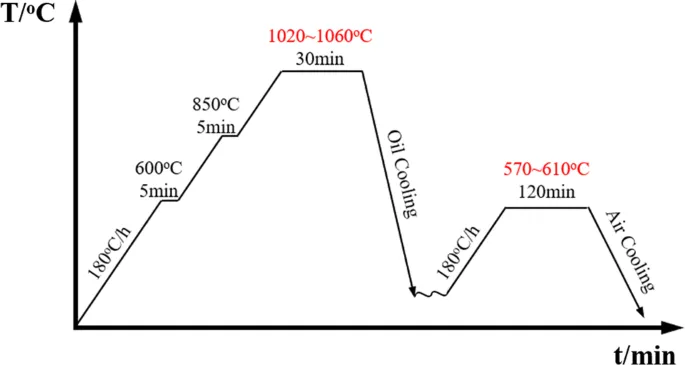Heat treatment is a critical process in the manufacturing of steel, as it can significantly enhance its mechanical properties and overall performance. One such steel alloy that benefits greatly from heat treatment is 4140 steel. Renowned for its exceptional strength, toughness, and wear resistance, 4140 steel has become a popular choice in various industries, including automotive, aerospace, and tooling.
In this article, we will explore the 4140 steel heat treatment methods, heat treatment temperature & cycles benefits, and applications.
Understanding 4140 Steel
4140 steel is a versatile low-alloy steel that contains chromium, molybdenum, and manganese. Its composition imparts excellent hardenability, making it suitable for heat treatment processes. This steel alloy exhibits high tensile strength, good fatigue resistance, and exceptional toughness, making it ideal for applications that require durability and reliability.
4140 Steel Chemical Compositions
The chemical composition of 4140 steel typically includes the following elements:
- Carbon (C): 0.38-0.43%
- Chromium (Cr): 0.80-1.10%
- Manganese (Mn): 0.75-1.00%
- Silicon (Si): 0.15-0.35%
- Phosphorus (P): ≤0.035%
- Sulfur (S): ≤0.040%
- Molybdenum (Mo): 0.15-0.25%
These elements contribute to the overall strength, hardness, and wear resistance of 4140 steel. The carbon content provides hardness and strength, while chromium enhances the steel’s corrosion resistance and wear resistance. Manganese improves hardenability, and silicon aids in deoxidation and enhances strength. Phosphorus and sulfur are impurities that are kept to a minimum to maintain the steel’s quality. Molybdenum contributes to the steel’s toughness and high-temperature strength.
Heat Treatment Methods
The heat treatment of 4140 steel typically involves a combination of processes, including annealing, normalizing, quenching, and tempering. Each step plays a crucial role in transforming the steel’s microstructure and optimizing its mechanical properties.
- Annealing: Annealing is the first step in the heat treatment process. It involves heating the steel to a specific temperature (around 800-850°C) and then slowly cooling it to room temperature. This process relieves internal stresses, refines the grain structure, and improves machinability.
- Normalizing: Normalizing is performed after annealing to further refine the microstructure. The steel is heated to a temperature slightly above the critical range (around 870-900°C) and then air-cooled. Normalizing enhances the steel’s strength and hardness while maintaining good ductility.
- Quenching: Quenching is a rapid cooling process that involves immersing the heated steel into a quenching medium, such as oil, water, or polymer. This step hardens the steel by transforming the austenite phase into martensite, a hard and brittle structure. The quenching process must be carefully controlled to prevent cracking or distortion.
- Tempering: Tempering is the final step in the heat treatment process. The quenched steel is reheated to a specific temperature (typically between 150-600°C) and then cooled in still air. Tempering reduces the brittleness of the steel, improves its toughness, and relieves residual stresses.
4140 steel heat treatment cycle

The heat treatment cycle for 4140 steel typically involves the following steps:
- Annealing: Start by heating the steel to around 800-850°C (1472-1562°F) and hold it at this temperature for a specific period of time. This process helps to relieve internal stresses and improve machinability. Afterward, slowly cool the steel in a furnace or by burying it in an insulating material like sand or ashes.
- Normalizing: Heat the annealed steel to a temperature between 870-920°C (1598-1688°F) and hold it at this temperature for a specific time. This step helps to refine the grain structure and improve mechanical properties. Afterward, cool the steel in still air.
- Quenching: Heat the normalized steel to a temperature between 830-870°C (1526-1598°F) and hold it at this temperature for a specific time. Then, rapidly cool the steel by immersing it in a quenching medium such as oil, water, or polymer. This step hardens the steel by transforming the austenite phase into martensite.
- Tempering: After quenching, the steel is too brittle and needs to be tempered to reduce its hardness and increase toughness. Heat the quenched steel to a temperature between 150-600°C (302-1112°F) and hold it at this temperature for a specific time. The exact temperature and time depend on the desired hardness and toughness. Finally, cool the steel in still air.
It’s important to note that the specific heat treatment parameters may vary depending on the desired properties and the manufacturer’s recommendations.
Benefits of Heat treatment
The heat treatment of 4140 steel imparts several key benefits, making it a preferred choice in various industries:
- Increased Strength: Heat treatment significantly enhances the strength and hardness of 4140 steel, making it suitable for demanding applications that require high tensile strength and resistance to wear and fatigue.
- Improved Toughness: The tempering process improves the toughness of 4140 steel, allowing it to withstand heavy impact and shock loading without fracturing.
- Machinability: Annealing and normalizing processes improve the machinability of 4140 steel, making it easier to shape and fabricate into complex components.
- Versatile Applications: 4140 steel finds applications in a wide range of industries, including automotive parts, tooling, gears, shafts, bolts, and structural components. Its exceptional strength and toughness make it ideal for demanding environments.
Conclusion
The heat treatment of 4140 steel is a crucial process that unlocks its full potential, enhancing its mechanical properties and making it suitable for a wide range of applications. By carefully controlling the annealing, normalizing, quenching, and tempering processes, manufacturers can achieve the desired balance of strength, toughness, and wear resistance. As industries continue to demand high-performance materials, 4140 steel remains a reliable choice, offering exceptional durability and reliability in challenging environments.
